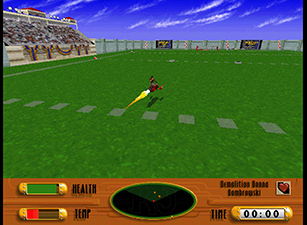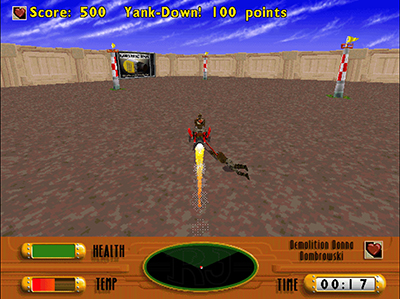Rocket Jockey is a science fiction arena sports game that has the player operating a rocket-propelled sled in three different modes of play: a race course, a soccer-like game where your rocket is throwing balls into goals and a total war setting, where the goal is to destroy other riders. Many of the same vibes you could get from Rocket League before Epic destroyed it was trail-blazed(?) in Rocket Jockey, and it’s a shame that it came out in a weird period of Windows gaming that would eventually lead to incompatibility on more modern systems.
 I have tried to really think about the gameplay loop of Rocket Jockey and why I have found it so fascinating for almost 30 years. I have an idea, but I want to talk briefly about the game’s history.
I have tried to really think about the gameplay loop of Rocket Jockey and why I have found it so fascinating for almost 30 years. I have an idea, but I want to talk briefly about the game’s history.
I experienced aging baby boomers lined up to buy Windows 95 the day it was released, and it confused and mystified me. There weren’t exactly day-one, must-have games for it, and what is the point of a new platform if not for the games you can play on it. (Later, I amended this belief to consist of new games AND whether or not it would let you get a job that pays your mortgage for decades.) We would eventually get great games like Civilization II and Diablo. My research indicates that Rocket Jockey was probably a mid-1996 release. I’ve always been a late adopter to Windows releases, avoiding them entirely if I could, but Rocket Jockey had a good enough vibe (box art, price, a guess at what the gameplay was, possibly print reviews) that I had to buy it. The game oozes style – it looks like nothing else, certainly nothing else of its time, and you’re instantly greeted with music from Dick Dale, which introduced me to his music, giving me small knowledge of surf culture I had, ahhh, missed up to that point in my life.
While there are three modes, the racing one is great for getting used to maneuvering your sled, but that’s it, really. Your sled can throw out cables on the left and right side that will attach to large soccer-like balls, columns and the sleds of other riders. (And the riders themselves, if you knocked them off their sleds.) It’s this part that makes this an experience perfect for a video game – there isn’t really a concept of a force in our reality that can have the cables never miss their target when deployed.
The most important part of all of this is that you can “lean” your rocket to some degree, but you can’t really stop it. A lot of times you get to turn the direction of your sled by hitting the arena wall and bouncing off it. And that is where the entertaining gameplay loop begins.
You’ll see the ball or another rider up ahead. If you successfully cable the ball there will probably be some momentum. By tilting your sled you can have it start to rotate around you, and hopefully you can release the cable at the right moment, at the right angle, to get it in the goal. You can also sort of have it bounce on the ground behind you. You don’t get forever with the cable attached in the ball mode: after a few seconds the cable retract on its own, so you’re fighting a clock here as well.
If you fail to grab the ball you are more or less going to go in a straight line until you encounter a column that you can cable to (and rotate around very quickly) because the turning radius of the sled itself is so big. So imagine the pleasure of grabbing the soccer ball, getting the rotation right and releasing it. Depending on where your sled is headed, you may not even see it go in, but just hear the bell and the crowd erupt to let you know you scored a goal. Awesome! And if you miss it, you are pretty much stuck for a few moments until you can use something else to turn around.
 In the war mode, inside the arena, you have a number of other riders around, and it’s possible to link to their sled or the rider themselves. It’s pure fun to grab another rider and take them for a ride they did not consent to. The instruction set for the rider is for them to get back to their sled and start it up, so you will hopefully get into a situation where the little dudes are running around the screen and it’s up to you if you want to cable to them and take them for a very brutal ride, far from their sled or not. And the computer can and will do the same to you.
In the war mode, inside the arena, you have a number of other riders around, and it’s possible to link to their sled or the rider themselves. It’s pure fun to grab another rider and take them for a ride they did not consent to. The instruction set for the rider is for them to get back to their sled and start it up, so you will hopefully get into a situation where the little dudes are running around the screen and it’s up to you if you want to cable to them and take them for a very brutal ride, far from their sled or not. And the computer can and will do the same to you.
It’s arcade arena fun in a way that Windows didn’t have a whole lot of in 1996.
I don’t believe Rocket Jockey was compatible with Windows XP, and it was certainly not playable off the disc for Windows 7. Recently, a version was massaged enough to work through Steam on modern computers. It has some problems with defining controls: I can’t reliably get any of the dozen USB joysticks or gamepads to work with it. I guess I can’t complain that much about the controls being difficult when you are ostensibly operating a futuristic crotch rocket that allows for only the general (waves hands) idea of turns while sitting on a small jet engine. You don’t really need anything that an analog stick might give you, so with some customization, the keyboard is playable – I try to steer with WASD on my left hand and shoot and connect cables using the arrow keys that are over to the right.
The remake looks and plays wonderfully, it is an accurate and fun re-imagining and recreation of Rocket Jockey. I can’t really get my gamepad to work with the remake either.
Last bit – this is one of my favorite pieces of game journalism. It is an interview with designer and developer Sean Callahan about Rocket Jockey, correctly describing it as a cult hit. Callahan did make an Xbox 360 version that sadly has never seen a release, as Rocket Science Games’ intellectual property is in an unknown place.
You can get the Windows 95 version here on Steam and the remake on itch.io.
- Rocket Jockey was played on Windows 10 using the Steam version.